 |
AS/NZS 3112 standard classic plugs and sockets |
 |
AS/NZS 3112 standard classic plugs and sockets |
 |
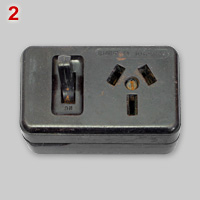 |
 |
 |
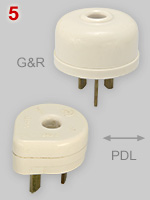 |
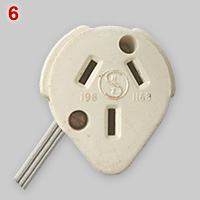 |
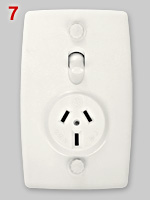 |
 |
| 1 | Porcelain
250V, 10A socket. Manufacturer: Spersom, brand of Sperryn (find details
below). Dating: late 1930s - early 1950s. {GR) |
| 2 | Bakelite 250V, 10A
socket, made in Australia by Energo. Possibly 1930-40s. {CrR} |
| 3 | Vintage plate and
switch. The round socket has been added more recently. {GR} |
| 4 |
Bakelite
two-way multi-plug. Indicated is: (i) Combined maximum
loading 10 Amps 250 Volts; (ii) Made to standards association of
Australia specifications; (iii) Garnite*. Pin
lengths: 20.5 mm (L, N) and 22.5 mm (earth). Dating: early 1940 until at least 1957. *Garnite was a trademark of ACI (see list of Australian manufacturers for details). |
| 5 | Obsolete plug models
with top cable
entry. This is potentionally unsafe because it
possible
to uncouple plug and socket by firmly pulling the cable, rather than
the plug. The right hand model has a droplet shape. The 'top' of the
droplet indicates the position of the earth pin. Manufacturer: G&R,
Christchurch, New Zealand (top, round model) and PDL (bottom, droplet
model). {GR} |
| 6 | Obsolete droplet-shaped socket made by PDL Ltd. The maching plug is shown in image no. 5. The socket is not a museum item, but a photo sent by John Hunter, an Australian museum visitor. |
| 7, 7a | 1950s
examples of standard 10A sockets. Manufacturers: PDL
Ltd, New Zealand (no. 7), HPM Australia (no. 7a). The wall plate is attached to the body of the socket by two fixing screws. For safety reasons a direct contact with metal parts of the socket has to be impossible, therefore older models have fixing screws with insulated heads. More modern methods to hide fixing screws are shown elsewhere. (7):{GR} and (7a):{PT} The writing of ONLY on HPM socket no. 8 is remarkable. |
 |
8 Switch / socket unit, installed in a house build in 1978. Rating: 10A-250V. The unit is an example of the Ring Grip Electrical 'Champagne Series'. Item code: CSC1. Switch is inextricably bound up with socket. {GH} Switch colour was either beige (left) or white (right). If desired Ring Grip could personalize the switch with a logo, trademark, symbol or name. The image shown right has been copied from a Ring Grip leaflet. |
 |
 |
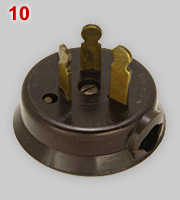 |
 |
 |
| For plug nos. 9 -12 applies that the earth pin
is 3 mm longer than L and N pins to make contact first. Moreover, each
pin has two recesses. Origin and original function of recesses is explained on the Locking Plug page (see image No. 17). |
|
| 9 | Classic,
Bakelite 10A plug. The shape of plugs in combination with a Bakelite
housing suggests that the plug dates back to the early 1950s.
Manufacturer: PDL
Ltd, New Zealand. {ChR} |
| 10 | Bakelite plug rated at 10A - 250V.
Manufacturer: HPM, Australia. {WN} |
| 11 | Bakelite plug rated at 10A - 250V.
Manufacturer: Marcolite, Australia. {WN} |
| 12 | Bakelite 'piggyback' type plug. Indicated rating: 240V S.C. 5A. Manufacturer unknown. Patent 942932. {WN} |
| Note Up
to the 1950s a mix of plug designs based on British
and U.S. types were used in Australia and
New Zealand (see examples below). They were
gradually phased out when the Australian
C112 standard (redefined as AS/NZS 3112 standard) was officially
recognized.
|
 |
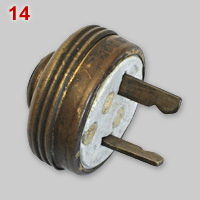 |
 |
 |
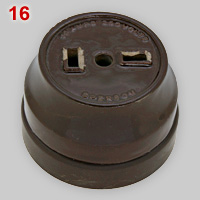 |
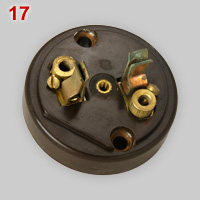 |
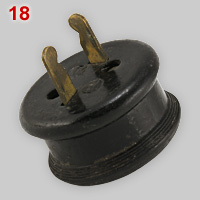 |
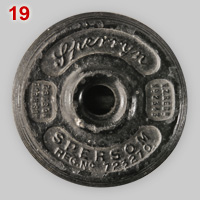 |
| 13 | Perpendicular,
or T-type socket, rated at 15A, 250V. Manufacturer:
URLWIN N.Z.* {ChR} * In 1936 Harry Urlwin started production of moulded equipment and plastic products in Christchurch, NZ. Urlwin sent Robert Stewart to Britain to learn plastics designs. In 1945 Stewart became a designer at Plastics and Diecasting Limited in Christchurch. In 1955 he bought the business and renamed it PDL Industries. |
| 14 |
T-type plug with porcelain base and brass
housing. No indication of
manufacturer. {ChR} |
| 15 | Plugs
with perpendicular positioned flat blades (nos. 14 and 18) closely
resembles U.S. T-slot plugs made in the 1920s-30s by the American
company Bryant Electrical Corp. The classic T-type plugs are similar to
modern Extra Low Voltage plugs (see uncommon
plug/socket
page for details). The Sperryn plug (no. 18) fits reasonably well in an
ELV socket, but the pin spacing of the porcelain/brass plug (no. 14) is
just too small to fit. Both plug nos. 14 and 18 fit easily in socket
nos. 13 and 16. It is clear that in the past tolerances
were a bit less strict than nowadays. |
| 16, 17 | T-type socket rated at 10A - 250V. Top
part has been made of steatite; bottom part (image no. 17) of Bakelite. Plug has been made in Britain by Sperryn & Co* using brand name Spersom. Dating: probably 1930s. |
| 18, 19 | T-type plug that matches with socket no. 16. Plug has been made of ebonite, a hard vulcanized natural rubber. The perpendicular orientation of flat pins results in a polarised plug, but line and neutral poles are not defined. The top of plug shows manufacturer's name (Sperryn) and brand name (Spersom, Reg. No. 723270), Australian Reg. No. 6162 and New Zealand Reg. No. 2343. Dating: because of the use of ebonite, possibly 1920s. {EG} |
| * |
Sperryn & Co, makers of
electrical accessories and fittings for gas and water industries, was
founded in 1889 in Birmingham, UK. In 1960 the company was acquired by
Delta Metal Co. In 2003 the Electrical Division of Delta was acquired
by
Eaton Corporation of USA. Sperryn used the brand Spersom for various
products. |
 |
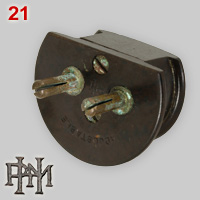 |
 |
| 20 | 3-way
multi-plug for BS 372 Part I plugs (5A) and NEMA 1-15 flat blade plugs.
Rating: 3A - 250V. Both British and U.S. plug types have been used in
Australia and New Zealand. Manufacturer: Anchor Electrical, formerly a
family-owned Indian electrical equipment brand, now a part of the
Japanese Panasonic Corporation. {WN} |
| 21, 22 |
BS 372 Part I plug. Although the type of
plug is rated at 5A in Britain, the shown model, made in Australia, is
rated at 10A. The unusual shape was marketed as 'adjustable'. Anyhow it can be used when an outlet offers limited space; see image no. 11. Manufacturer: HPM (Australia). {WN} |
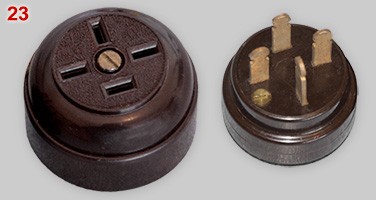 Pictures have been taken by Murray Anderson. Peter Taylor identified socket and plug and provided information given right. |
23. "Look-alikes" Plug and pins have dimensions comparable to 10A domestic plugs and may look as an uncommon, obsolete single or three-phase type. However, socket and plug were used to connect telephones. Australian versions of British BPO 300 series telephones were used in the 1930s - '60 (see Bob's Old Phones). The 1962 PMG* Technicians Handbook states that plug and socket "... enable the subscriber to operate his service from any one of several locations by carrying the telephone to the point most suited to the occasion. The cord from a telephone is terminated on a plug which is inserted into sockets located at points selected by the subscriber." * Postmaster-General's Department was a department of the Australian federal government, among others responsible of postal and telegraphic services throughout Australia, from 1901 - 1975. |
D i g i t a l M u s e u m o f P l u g s a n d S o c k e t s